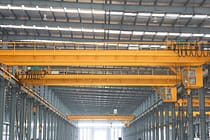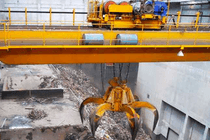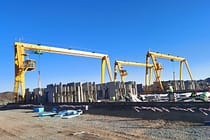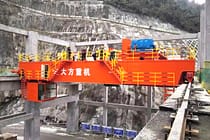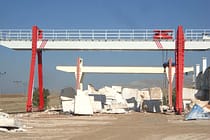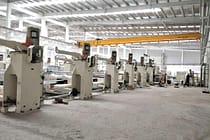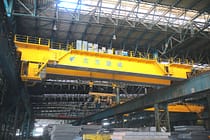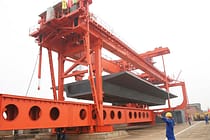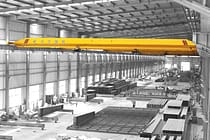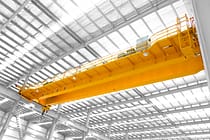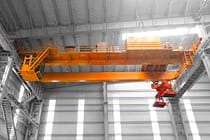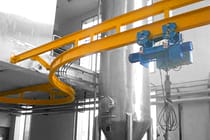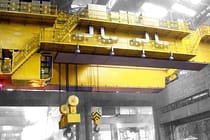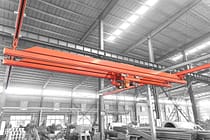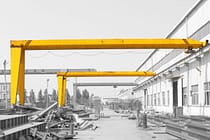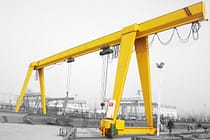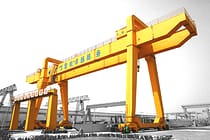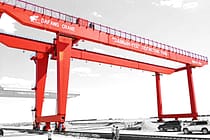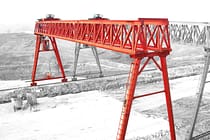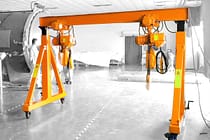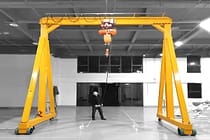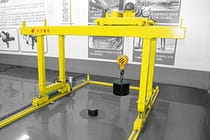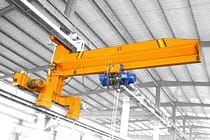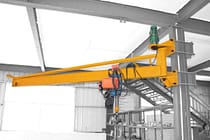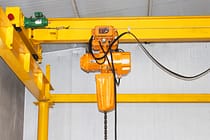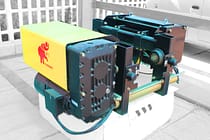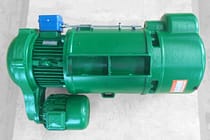Deadly Gantry Crane Accident Derailment: Caused by a Little Loose Rail Clamp
Table of Contents
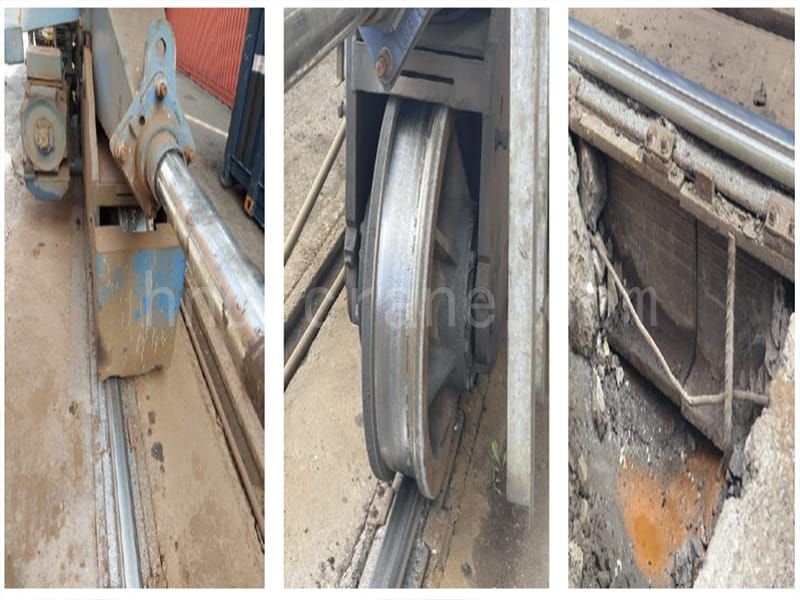
Gantry cranes in municipal projects are greatly affected by wind, and crane derailments and overturning accidents caused by wind occur from time to time. This article analyzes the cause of a derailment gantry crane accident caused by a typical wind force, summarizes some misunderstandings and illegal crane operation phenomena that are common to operators during the use of wind-resistant and anti-skid devices of gantry cranes, and proposes corresponding safety measures for your reference and discussion.
What Gantry Crane Accident Happened
A gantry crane (model MHE10+10t-31m A3, span 31m, height 9m, equipment weight 33t) was normally constructed at the construction site of a subway project. When working around 8 p.m., the person in charge of project safety received a yellow warning notice of high winds (gusts of approximately 9 mph), so they notified the site to stop all operations, arranged for the gantry crane driver to use the rail clamp to secure it, and all personnel were evacuated.
At approximately 10 o’clock on the 21st, the instantaneous wind was very strong, and the project safety officer immediately arranged for personnel to inspect the construction site to prevent accidents. During the inspection, engineering safety personnel discovered a gantry crane accident—the crane was significantly skewed, one side of the outrigger was out of track (Figure 1), and one side of the track was broken (Figure 2).
The engineering safety personnel immediately notified the person in charge of the project, and then arranged for the temporary fixation of the gantry crane to prevent further consequences from the gantry crane accident. After the yellow warning of high winds was lifted, emergency measures were taken to eliminate the dangerous condition caused by the gantry crane accident.
This gantry crane accident highlights the critical importance of following wind warning protocols and securing heavy equipment properly in open-air construction environments.

Gantry Crane Accident Derailment Analysis
Since the accident did not cause any casualties or significant economic losses, the user unit, in order to avoid further escalation, lifted the dangerous state of the gantry crane accident without setting up proper on-site protection, which may lead to structural failure.
Some of the information from the gantry crane accident scene is incomplete or damaged. The findings from the investigation of the accident site and the statements provided by on-site personnel after the incident are as follows.
- The wheels on the north and west sides of the crane derailed, and the wheels on the south side of the crane did not derail.
- There is obvious bending in the eastern half of the broken track in the southern part of the crane (hereinafter referred to as the broken track on the east side). The bending place is 7.6m away from the broken place, and there are obvious friction marks on the left side of the top surface of the broken track on the east side with the crane on the same paint surface (Figure 3).
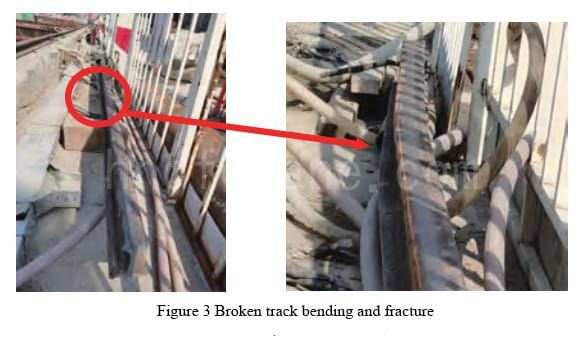
- The clamps of the rail clamp on the north side are all in an offset deformation state, as shown in Figure 4.

- There are obvious deflection and fracture of the track on the south side. The situation is shown in Figures 5 and 6.

- There are obvious friction marks of about 15m in length on the track on the north side of the crane.
- On-site investigation found that there were friction marks on the edge of the rail surface at the fracture of the southern track of the crane.
- The manual rail clamping test of the south side rail clamping device is analyzed and it is concluded that the rail clamping device can lock the track tightly. During the test, the rail clamping device can operate freely, and no operating jamming is found. You can pass the test
It is preliminarily determined that the rail clamp meets the requirements for use.
Analysis Cause of the Gantry Crane Accident
Before the incident, the crane was non-operational. The northern rail clamp was lowered but not locked (an operational error, with no safety inspection carried out), while the southern rail clamp had not been lowered at all. Due to a strong instantaneous wind, the crane began to move from west to east under wind load, marking the early development of the gantry crane accident.
As the crane moved eastward, the northern rail clamp and the track became stuck, causing the southern part of the crane to move faster than the northern part. This speed difference led the crane to rotate during its eastward motion. The friction between the northern rail clamp and the track increased, causing the northern part of the crane to stop moving. This mechanical imbalance further escalated the gantry crane accident.
At the same time, wind load and the crane’s inertia caused the southern part to continue moving eastward, increasing the overall rotation. The rotation resulted in the east side of the southern crane leg shifting inward toward the track and the west side shifting outward. This displacement bent the track, and under the combined stress of both sets of wheels, the track eventually broke—intensifying the gantry crane accident.
According to the investigation at the accident site, it was confirmed that the crane moved from west to east due to wind. During the movement, the northern rail clamp rubbed against the track, creating resistance over a distance of no less than 15 meters. The southern section ran faster, causing the crane to rotate—a key mechanical failure point in the gantry crane accident.
As the crane rotated, the northern rail clamp also turned with it, increasing friction and stuck resistance until the crane's eastward movement suddenly stopped. At that point, the sliding friction turned into static friction. Simultaneously, the southern part, driven by wind and inertia, continued eastward. This rotation and differential motion caused the rear wheel to create a bending moment on the broken rail, leading to derailment—ultimately culminating in a severe gantry crane accident (Figure 7).
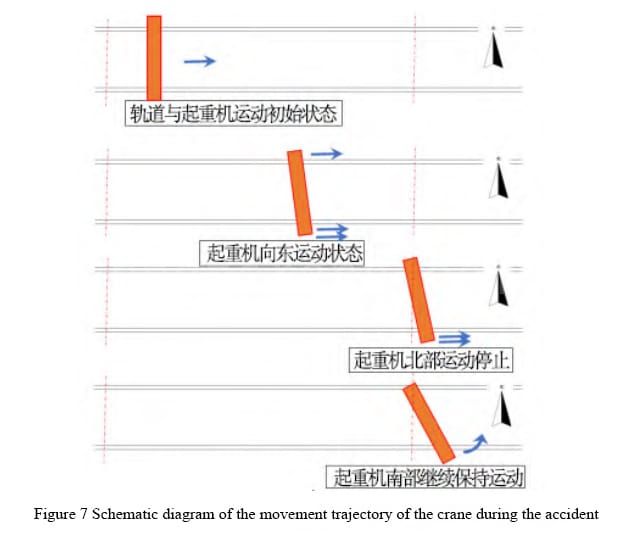
After professional calculations by engineers, we learned that the overall wind resistance and anti-skid force of the crane in the stationary state is 1.23 times the wind load in the case of Category 9 high winds. On the whole, the crane is safe.
However, taking into account that the wind resistance and anti-skid force of the unused rail clamp legs is less than 1/2 of the 9-level high wind load, this leg will be displaced (the unilateral force generated by the wind load 38 394.6N is much greater than the wind resistance and anti-skid force 1980N produces the following conditions: the unused rail clamp legs temporarily relieve the frictional resistance of the crane operation, taking into account that the movement of one leg will cause the crane to produce significant elastic deformation, coupled with its own wind vibration, resulting in a significant increase in sliding force.
At this time, the crane slides (the force generated by the wind load is 76 789.2N, which is slightly greater than the wind resistance and anti-skid force of 75 000N), which reduces the frictional resistance of the crane from the maximum static friction to sliding friction, and the overall wind resistance and anti-skid force continues to decrease, causing the crane to run with the wind and the operating speed is accelerated. In the case of inconsistent friction between the outriggers on both sides, the crane will eventually skew as a whole until it derails or breaks the rail.
Gantry Crane Accident Preventive Measures
Raise the awareness of equipment managers and operators
During the inspection, inspection and safety inspection work, it has been found many times that the gantry crane has not clamped all the rail clamp pliers in accordance with the regulations. Many managers believe that it is feasible to clamp only one-sided rail clamp pliers, but the wind load of the crane in the accident has reached nearly 3 times the weight of the crane under the 9-level wind conditions, which is unimaginable for many managers and operators. Do a good job of training managers and operators to understand the analysis of the causes of some accidents, improve personnel awareness, and recognize the importance of crane wind resistance and anti-skid.
Design the use of the crane well
The two legs of gantry cranes in many municipal projects span long and deep foundation pits, and the operators are not easy to reach or unable to reach the opposite legs. From the design of the crane, how one worker clamps all the rail clamp pliers is not considered. The situation. When designing equipment positioning, it is advisable to set the crane stop position at the passable foundation pit passage; the crane driver passage of the same track can be set to both sides of the foundation pit, and only the driver can be arranged to operate multiple crane wind-resistant and anti-skid devices in the foundation pit on one side; the crane driver passage can be set to the opposite side of the main material area, and the signal worker and the driver respectively operate the wind-resistant and anti-skid devices of heavy machinery.
Ensure the reliability of the wind-resistant and anti-skid device of the gantry crane
1. The wind-resistant and anti-skid function of unmodified gantry cranes often has situations where the actual effect does not reach the design value. For example, the manual of the gantry crane generally points out that the manufacturing value of the structural parts is ±10% of the design value. In order to save costs, manufacturers will basically approach the lower limit, resulting in a decrease in the overall wind and anti-skid resistance of the gantry crane.
2. The clamping braking force of the clamp rail pliers cannot reach the maximum value in the manual. One is that the operation of the operator may not meet this requirement, and the other is that the surface of the clamp rail pliers is notched and worn.
3. Due to the changeable weather, the wind may exceed the forecast. In the inspection, testing and safety inspection work, it was found that more wind-resistant and anti-skid devices of gantry cranes have been upgraded, such as the addition of wind ropes (internal chain safety devices, etc.), the original iron shoes wind-resistant and anti-skid devices, and the addition of rail clamp pliers, etc., can often achieve good wind-resistant and anti-skid effects.
Pay attention to the inspection work after strong gusts of wind
In this accident, the person in charge of project safety immediately arranged for personnel to inspect the construction site after the strong gust of wind to prevent accidents and prevent the situation from further expanding. If temporary reinforcement measures are lacking after the derailment of the crane in the accident, it is highly likely that the crane will fall into the foundation pit after the next strong gust of wind on the same day, causing the support in the foundation pit and the crane to be damaged. It can be seen that the inspection after the strong gust of wind can avoid the expansion of some accidents.
Conclusion
Accident prevention is an important part of the daily supervision of safe production. Improving safety awareness, developing good operating habits, and improving equipment safety performance are the most effective guarantees to ensure the safety of gantry cranes and prevent accidents. As a more dangerous equipment in municipal engineering, gantry cranes, equipment managers, and operators should be more technically, risk-aware and able to operate. At the same time, users should strengthen safety management, strengthen education and training, conduct regular inspections of equipment, and stop and correct violations by operators in a timely manner to ensure construction safety.
Send Your Inquiry
- Email: sales@hndfcrane.com
- WhatsApp: +86 191 3738 6654
- Telegram: +86 191 3738 6654
- Tel: +86-373-581 8299
- Fax: +86-373-215 7000
- Add: Changnao Industrial District, Xinxiang City, Henan Province, China
 WeChat
WeChat
